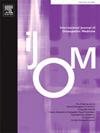Potential impact of an osteopathic intervention for internationally adopted children with fetal alcohol spectrum disorder (FASD); a prospective case series
IF 1.5
4区 医学
Q2 MEDICINE, GENERAL & INTERNAL
引用次数: 0
Abstract
Objective
To explore the potential impact of Osteopathic Manipulative Treatment (OMT) on Health-Related Quality of Life (HRQoL) on internationally adopted children with fetal alcohol spectrum disorder (FASD).
Methods
Twelve children with FASD adopted from Eastern European countries were recruited in this prospective observational study. HRQoL was collected using the Kidscreen-52 questionnaire. The participants followed a six-month intervention plan that included 4 bi-weekly OMT sessions and 4 monthly OMT sessions.
Results
Significant differences were detected in the pre-post intervention values (p = 0.001), interaction by group (p = 0.048), in the results of four dimensions (Moods & Emotions, p = 0.008, Self-Perception, p = 0.016, School Environment, p = 0.008 and Social Acceptance, p = 0.017) and in the overall assessment for parents’ version (p = 0.002). A mild adverse effect (pain/discomfort) was reported by one participant (8.3 % of the total sample) after one session.
Conclusion
This study shows that a six-month OMT intervention is a feasible personalized intervention for children and adolescents with FASD coming from international adoption. The study suggests that measuring instruments can detect changes in HRQoL over time, pointing out the need to develop a specific HRQoL assessment instrument for children with FASD to be applied in future studies. Even though promising significant changes were observed, these were most likely not only due to OMT, and further studies are required before assuming these could be due to osteopathic care.
骨科干预对国际收养的胎儿酒精谱系障碍(FASD)儿童的潜在影响前瞻性病例系列
目的探讨骨科手法治疗(OMT)对国际收养胎儿酒精谱系障碍(FASD)患儿健康相关生活质量(HRQoL)的潜在影响。方法从东欧国家收养的12名FASD儿童进行前瞻性观察研究。HRQoL采用Kidscreen-52问卷收集。参与者遵循六个月的干预计划,包括4次每两周一次的OMT治疗和4次每月的OMT治疗。结果在干预前后值(p = 0.001)、组间交互作用(p = 0.048)、四个维度(情绪和情绪;情绪(p = 0.008)、自我知觉(p = 0.016)、学校环境(p = 0.008)和社会接受(p = 0.017)以及家长的整体评估(p = 0.002)。一名参与者(占总样本的8.3%)在一次疗程后报告了轻微的不良反应(疼痛/不适)。结论对国际收养的FASD儿童和青少年进行为期6个月的OMT干预是一种可行的个性化干预。研究表明,测量仪器可以检测HRQoL随时间的变化,并指出有必要为FASD儿童开发一种专门的HRQoL评估工具,以便在未来的研究中应用。尽管观察到有希望的显著变化,但这些变化很可能不仅仅是由于OMT,在假设这些变化可能是由于整骨疗法治疗之前,还需要进一步的研究。
本文章由计算机程序翻译,如有差异,请以英文原文为准。
求助全文
约1分钟内获得全文
求助全文
来源期刊
CiteScore
2.20
自引率
36.80%
发文量
42
审稿时长
3 months
期刊介绍:
The International Journal of Osteopathic Medicine is a peer-reviewed journal that provides for the publication of high quality research articles and review papers that are as broad as the many disciplines that influence and underpin the principles and practice of osteopathic medicine. Particular emphasis is given to basic science research, clinical epidemiology and health social science in relation to osteopathy and neuromusculoskeletal medicine.
The Editorial Board encourages submission of articles based on both quantitative and qualitative research designs. The Editorial Board also aims to provide a forum for discourse and debate on any aspect of osteopathy and neuromusculoskeletal medicine with the aim of critically evaluating existing practices in regard to the diagnosis, treatment and management of patients with neuromusculoskeletal disorders and somatic dysfunction. All manuscripts submitted to the IJOM are subject to a blinded review process. The categories currently available for publication include reports of original research, review papers, commentaries and articles related to clinical practice, including case reports. Further details can be found in the IJOM Instructions for Authors. Manuscripts are accepted for publication with the understanding that no substantial part has been, or will be published elsewhere.

 求助内容:
求助内容: 应助结果提醒方式:
应助结果提醒方式:


